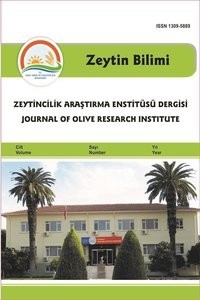Karaburun ve Seferihisar Bölgelerinden Hasat Edilen Erkence (Hurma) Zeytin Çeşidinden Elde Edilen Yağların Bazı Kimyasal Özelliklerin Karşılaştırılması
Urla, Seferihisar ve Karaburun’da yetiştirilen Erkence zeytin çeşidinde, meyveler daha dalındayken olgunlaşmakta ve hiçbir işleme tabi tutulmadan dalından toplanıp tüketilebilmektedir. Bu olgunlaşmaya “Hurmalaşma”, zeytin meyvesine de “Hurma” zeytin denilmektedir. Çalışmamızda 2010/11 yılında farklı bölgelerden (Karaburun ve Seferihisar) hasat edilen Hurma zeytinlerden elde edilen yağlarda serbest yağ asitliği miktarı, peroksit değeri, K232 ve K270 değerleri, toplam klorofil miktarı, toplam fenolik madde miktarı, α-tokoferol miktarı, yağ asidi kompozisyonu, DPPH ve ABTS radikal süpürücü aktivite (RSA) analizleri yapılmıştır. Araştırma sonunda bölgelere göre zeytin meyvelerinin % yağ miktarının, elde edilen yağların toplam klorofil miktarının, palmitik asit, oleik asit, toplam doymuş yağ asidi (TDYA) ve toplam tekli doymamış yağ asidi (TTDYA) yüzdelerinin istatistiksel olarak önemli oranda farklı olduğu tespit edilmiştir (P
Anahtar Kelimeler:
Erkence, Hurma, toplam fenolik madde, α-tokoferol, DPPH, ABTS
Comparison of Some Chemical Properties of Oils Obtained From Erkence (Hurma) Olive Variety Harvested From Karaburun and Seferihisar Regions
The fruits of Erkence olive cultivars, where grown in Urla, Karaburun and Seferihisar, are maturing on branch and can be consumed without any treatment. The fruit of olive is called as "Hurma" and this maturation is called as "Hurmalaşma". In our study, free fatty acidity, peroxide value, K232 and K270 values, total chlorophyll content, total phenolic compound, α-tocopherol content, fatty acid composition, DPPH and ABTS radical scavenging activity (RSA) were analyzed in the olive oil which were obtained from Hurma olives, in different regions (Karaburun and Seferihisar), in the harvest season of 2010/11. At the end of the research, according to the reagions, the oil percent of olive fruit, total chlorophyll content, palmitic acid, oleic acid, total saturated fatty acid (SFA) and the total monounsaturated fatty acid (MUFA) percentages of oils were found to be statistically significantly different (P
Keywords:
Erkence, Hurma, total phenol, α-tocopherol, DPPH, ABTS,
- ISSN: 1309-5889
- Başlangıç: 2010
- Yayıncı: Zeytincilik Araştırma Enstitüsü Müdürlüğü - İZMİR
Sayıdaki Diğer Makaleler
Sonikasyonla Zeytinaltı Atıksuyundan Fenolik, Aromatik ve Toksik Bileşiklerin Giderimi
Delia Teresa SPONZA, Rukiye ÖZTEKİN
Ferit ÇOBANOĞLU, Renan TUNALIOĞLU
Murat ŞEKER, Mehmet Ali GÜNDOĞDU, Muhammet Kemal GÜL, Nilüfer KALECİ
Didar SEVİM, Oya KÖSEOĞLU, Yeşim ALTUNOĞLU, Handan ATAOL ÖLMEZ, Elif Burçin BÜYÜKGÖK, Şenay YAMAN
